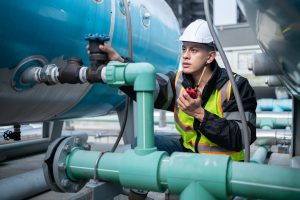In today’s fast-paced industrial environment, operational continuity is paramount. Whether you’re managing a manufacturing facility, commercial building, or residential complex, unexpected pipe maintenance can bring operations to a grinding halt. However, innovative pipe freezing technology offers a revolutionary solution that’s transforming how businesses approach pipeline maintenance and repairs.
Understanding Pipe Freezing Technology
Pipe freezing, also known as line stopping or pipe plugging, is a sophisticated technique that creates temporary ice plugs within pipelines without shutting down entire systems. This method uses specialised equipment to rapidly freeze water or other liquids within specific sections of pipe, creating solid barriers that allow maintenance teams to work on isolated sections whilst the rest of the system remains operational.
The process involves clamping freezing equipment around the pipe and using liquid nitrogen or carbon dioxide to achieve temperatures as low as -196°C. This extreme cold creates ice plugs that can withstand significant pressure, effectively sealing off sections of the pipeline for safe maintenance work.
The Traditional Maintenance Challenge
Conventional pipeline maintenance typically requires complete system shutdowns, which can result in:
- Extended downtime affecting productivity and revenue
- Complex drainage procedures that waste valuable resources
- Lengthy refilling and recommissioning processes once work is complete
- Risk of contamination during system restart
- Significant labour costs associated with extended maintenance windows
For businesses operating 24/7 facilities such as hospitals, data centres, or manufacturing plants, these disruptions can be catastrophic, potentially costing thousands of pounds per hour in lost productivity.
How Pipe Freezing Minimises Operational Disruption
Localised Isolation
Rather than shutting down entire systems, pipe freezing allows for precise isolation of specific pipeline sections. This targeted approach means that unaffected areas can continue operating normally, dramatically reducing the scope of disruption. For instance, in a multi-storey office building, maintenance on one floor’s water supply needn’t affect operations on other levels.
Rapid Implementation
Modern pipe freezing equipment can create effective ice plugs within 15-30 minutes, depending on pipe diameter and contents. This quick setup time means maintenance windows can be significantly reduced compared to traditional methods that might require hours of preparation and system draining.
No System Drainage Required
One of the most significant advantages is eliminating the need to drain extensive pipeline networks. This not only saves time but also conserves valuable resources such as treated water, chemicals, or other process fluids that would otherwise be wasted during conventional maintenance procedures.
Maintained System Pressure
Because the majority of the system remains operational, pressure levels are maintained throughout the network. This prevents issues such as air ingress, contamination risks, and the complex recommissioning procedures typically required after full system shutdowns.
Enhanced Safety
Pipe freezing creates a physical barrier that’s more reliable than valve isolation alone. This redundant safety measure provides additional protection for maintenance personnel whilst ensuring absolute isolation of the work area.
Applications Across Industries
Healthcare Facilities
Hospitals and medical centres require uninterrupted water and heating services. Pipe freezing enables critical repairs without compromising patient care or sterile environments. Operating theatres can continue functioning whilst maintenance occurs elsewhere in the building.
Manufacturing Operations
Production facilities often cannot afford extended shutdowns due to tight schedules and high operational costs. Pipe freezing allows for strategic maintenance during brief production windows without requiring complete process shutdowns.
Commercial Buildings
Office complexes, shopping centres, and hotels can maintain comfort levels and basic services for occupants whilst addressing pipeline issues in specific areas.
Residential Complexes
Large residential developments can continue providing services to most residents whilst addressing localised maintenance requirements.
Environmental and Economic Benefits
The environmental advantages of pipe freezing are substantial. By eliminating the need to drain and refill systems, this technology significantly reduces water waste and prevents the discharge of potentially harmful chemicals or treated water into drainage systems.
From an economic perspective, the cost savings are multifaceted:
- Reduced downtime costs through maintained operations
- Lower labour expenses due to shorter maintenance windows
- Resource conservation by avoiding system drainage
- Decreased risk of contamination or system damage
- Improved scheduling flexibility allowing maintenance during optimal windows
Safety Considerations and Best Practices
Whilst pipe freezing is generally safer than traditional methods, it requires expertise and proper equipment. Professional pipe freezing services ensure:
- Proper pressure monitoring throughout the process
- Appropriate freeze location selection to prevent system damage
- Safe handling of cryogenic materials
- Compliance with relevant health and safety regulations
- Emergency procedures should unexpected issues arise
Choosing the Right Pipe Freezing Solution
When considering pipe freezing for your operations, several factors should guide your decision:
Pipe Material and Size: Different materials and diameters require specific approaches and equipment.
System Pressure: High-pressure systems need more robust freezing solutions and additional safety measures.
Fluid Type: Water, glycol solutions, and other fluids each present unique freezing challenges.
Access Requirements: Equipment placement and workspace limitations affect technique selection.
Timeframe: Understanding how long the freeze needs to be maintained influences equipment choice.
Conclusion
Pipe freezing technology represents a paradigm shift in pipeline maintenance, offering businesses the opportunity to address infrastructure needs without the traditional penalties of extended downtime. By enabling localised, rapid, and safe maintenance procedures, this innovative approach minimises operational disruption whilst maintaining the highest safety standards.
For organisations seeking to optimise their maintenance strategies, reduce operational costs, and improve overall efficiency, pipe freezing presents a compelling solution. As industries continue to demand greater operational continuity, this technology will undoubtedly play an increasingly vital role in modern infrastructure management.
The investment in professional pipe freezing services pays dividends through reduced downtime, enhanced safety, and improved operational flexibility—making it an essential consideration for any business serious about maintaining competitive advantage through operational excellence.


